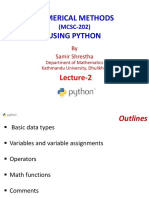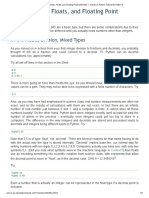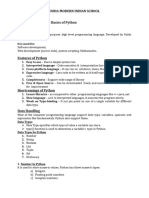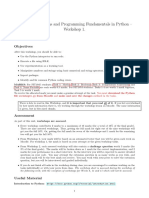Python as a Calculator — Python Numerical Methods
Uploaded by
shengxiyang007Python as a Calculator — Python Numerical Methods
Uploaded by
shengxiyang007Python as a Calculator — Python Numerical Methods https://pythonnumericalmethods.studentorg.berkeley.edu/notebooks/chapter01.02-Python-as-A-Calc...
This notebook contains an excerpt from the Python Programming and Numerical Methods - A Guide Contents
for Engineers and Scientists, the content is also available at Berkeley Python Numerical Methods. Basic Data Types
The copyright of the book belongs to Elsevier. We also have this interactive book online for a better
learning experience. The code is released under the MIT license. If you find this content useful, please
consider supporting the work on Elsevier or Amazon!
< 1.1 Getting Started with Python | Contents | 1.3 Managing Packages >
Python as a Calculator
We will introduce you to Python by demonstrating features found in any standard graphing calculator. An
arithmetic operation is either addition, subtraction, multiplication, division, or powers between two numbers. An
arithmetic operator is a symbol that Python has reserved to mean one of the aforementioned operations. These
symbols are + for addition, - for subtraction, * for multiplication, / for division, and ** for exponentiation.
We say an instruction or operation is executed when it is resolved by the computer. An instruction is executed at
the command prompt by typing it where you see the >>> symbol in the Python shell (or In [1]: sign in Ipython)
and then pressing Enter. Or type it in the code cell in Jupyter notebook and pressing Shift + Enter. Since we
will use Jupyter notebook for the rest of the book, here we will show all the examples in Ipython shell (Python
shell is similar), so that you can familiar with different options.
TRY IT! Compute the sum of 1 and 2.
In [1]: 1 + 2
Out[1]: 3
An order of operations is a standard order of precedence that different operations have in relationship to one
another. Python utilizes the same order of operations that you learned in grade school. Powers are executed
before multiplication and division, which are executed before addition and subtraction. Parentheses, (), can also
be used in Python to supersede the standard order of operations.
3∗4
TRY IT! Compute .
(22 +4/2)
In [2]: (3*4)/(2**2 + 4/2)
Out[2]: 2.0
TIP! You may have noticed Out[2] is the resulting value of the last operation executed. You can use _ symbol to
represent this result to break up complicated expressions into simpler commands.
TRY IT! Compute 3 divided by 4, then multiply the result by 2, and then raise the result to the 3rd power.
In [3]: 3/4
Out[3]: 0.75
In [4]: _*2
Out[4]: 1.5
In [5]: _**3
Out[5]: 3.375
Python has many basic arithmetic functions like sin, cos, tan, asin, acos, atan, exp, log, log10 and sqrt stored
in a module (We will explain it later in this chapter) called math. We can import this module first to get access to
these functions.
In [6]: import math
TIP! In Jupyter notebook and Ipython, you can have a quick view of what’s in the module by type the module
name + dot + TAB. Furthermore, if you type the first few letters of the function and press TAB, it could
automatically complete the function for you, the so called - TAB completion.
1 of 4 2024-04-07, 4:08 a.m.
Python as a Calculator — Python Numerical Methods https://pythonnumericalmethods.studentorg.berkeley.edu/notebooks/chapter01.02-Python-as-A-Calc...
The way we use these mathematical functions is module.function, the inputs to them are always placed inside of
parentheses that are connected to the function name. For trigonometric functions, it is useful to have the value of
𝜋 available. You can call this value at any time by typing math.pi in the code cell. Note that the value of 𝜋 is
stored in Python to 16 digits.
TRY IT! Find the square root of 4.
In [7]: math.sqrt(4)
Out[7]: 2.0
TRY IT! Compute the 𝑠𝑖𝑛( 𝜋2 ).
In [8]: math.sin(math.pi/2)
Out[8]: 1.0
Python will compose functions as you would expect, with the innermost function being executed first. The same
holds true for function calls that are composed with arithmetic operations.
TRY IT! Compute 𝑒𝑙𝑜𝑔10 .
In [9]: math.exp(math.log(10))
Out[9]: 10.000000000000002
Note that the log function in Python is 𝑙𝑜𝑔𝑒 , or the natural logarithm. It is not 𝑙𝑜𝑔10 . If you want to use 𝑙𝑜𝑔10 , you
need to use math.log10.
TIP! You can see the result above should be 10, but it is showing 10.000000000000002, this is due to Python’s
number approximation, which we will learn more in chapter 9.
3
TRY IT! Compute 𝑒 4
In [10]: math.exp(3/4)
Out[10]: 2.117000016612675
TIP! Using the UP ARROW in the command prompt recalls previous commands that were executed. If you
accidentally type a command incorrectly, you can use the UP ARROW to recall it, and then edit it instead of
retyping the entire line.
Many times, when you use a function in Python, you want to get some help on the context of the function. In
Ipython or Jupyter notebook you can view the description of any function by typing function?, that is the
question mark is a shortcut to get help. If you see a function you are unfamiliar with, it is good practice to use the
question mark before you asking your instructors what a specific function does.
2 of 4 2024-04-07, 4:08 a.m.
Python as a Calculator — Python Numerical Methods https://pythonnumericalmethods.studentorg.berkeley.edu/notebooks/chapter01.02-Python-as-A-Calc...
WARNING! For some functions, the help file can be extremely complicated and wordy, even for simple functions.
In these cases, do not be afraid to ask your instructor for help.
TRY IT! Use the question mark to find the definition of the factorial function
In [11]: math.factorial?
Signature: math.factorial(x, /)
Docstring:
Find x!.
Raise a ValueError if x is negative or non-integral.
Type: builtin_function_or_method
Python will raise an ZeroDivisionError when you have expression 1/0, which is infinity, to remind you.
In [12]: 1/0
---------------------------------------------------------------------------
ZeroDivisionError Traceback (most recent call last)
<ipython-input-12-9e1622b385b6> in <module>()
----> 1 1/0
ZeroDivisionError: division by zero
You can type math.inf at the command prompt to denote infinity or math.nan to denote something that is not a
number that you wish to be handled as a number. If this is confusing, this distinction can be skipped for now; it will
be explained more clearly when it becomes important. Finally, Python can also handle the imaginary number.
TRY IT! 1/∞, and ∞ ∗ 2 to verify that Python handles infinity as you would expect.
In [13]: 1/math.inf
Out[13]: 0.0
In [14]: math.inf * 2
Out[14]: inf
TRY IT! Compute ∞/∞
In [15]: math.inf/math.inf
Out[15]: nan
TRY IT! Compute sum 2 + 5i
In [16]: 2 + 5j
Out[16]: (2+5j)
Note that, in Python imaginary part is using j instead of i to represent.
Another way to represent complex number in Python is to use the complex function.
In [17]: complex(2,5)
Out[17]: (2+5j)
Python can also handle scientific notation using the letter e between two numbers. For example,
1𝑒6 = 1000000 and 1𝑒 − 3 = 0.001 .
TRY IT! Compute the number of seconds in 3 years using scientific notation.
In [18]: 3e0*3.65e2*2.4e1*3.6e3
Out[18]: 94608000.0
TIP! Every time when we type the function in math module, we always type math.function_name. Alternatively,
there is a simpler way, for example, if we want to use sin and log from math module, we could import them this
way: from math import sin, log. Then you all you need to do when using these functions is using them
3 of 4 2024-04-07, 4:08 a.m.
Python as a Calculator — Python Numerical Methods https://pythonnumericalmethods.studentorg.berkeley.edu/notebooks/chapter01.02-Python-as-A-Calc...
directly, for example, sin(20) or log(10).
Basic Data Types
We just learned to use Python as a calculator to deal with different data values. In Python, there are a few data
types we need to know, for numerical values, int, float, and complex are the types associated with the values.
• int: Integers, such as 1, 2, 3, …
• float: Floating-point numbers, such as 3.2, 6.4, …
• complex: Complex numbers, such as 2 + 5j, 3 + 2j, …
You can use function type to check the data type for different values.
TRY IT! Find out the data type for 1234.
In [19]: type(1234)
Out[19]: int
TRY IT! Find out the data type for 3.14.
In [20]: type(3.14)
Out[20]: float
TRY IT! Find out the data type for 2 + 5j.
In [21]: type(2 + 5j)
Out[21]: complex
Of course, there are other different data types, such as boolean, string and so on, we will introduce them later in
the book.
In this section, we talked about how to use Python as a calculator by running commands in the Python shell. Let’s
go ahead to learn more about the managing packages, i.e. how to install, upgrade, and remove the packages
before we do more coding.
< 1.1 Getting Started with Python | Contents | 1.3 Managing Packages >
© Copyright 2020.
4 of 4 2024-04-07, 4:08 a.m.
You might also like
- Exercise 2: X TFC TPP APP MPP TV C AVC MC AFC ATC100% (1)Exercise 2: X TFC TPP APP MPP TV C AVC MC AFC ATC2 pages
- Numerical Methods Using Python: (MCSC-202)No ratings yetNumerical Methods Using Python: (MCSC-202)29 pages
- Lab 03 - Escape Sequence, Casting and Math FunctionNo ratings yetLab 03 - Escape Sequence, Casting and Math Function7 pages
- Decimals, Floats, and Floating Point Arithmetic Tutorial For Python 3 PDFNo ratings yetDecimals, Floats, and Floating Point Arithmetic Tutorial For Python 3 PDF4 pages
- A Very Basic Introduction To Scientific Python ProgrammingNo ratings yetA Very Basic Introduction To Scientific Python Programming33 pages
- Unit Iv - Python Functions, Modules and Packages0% (1)Unit Iv - Python Functions, Modules and Packages102 pages
- F-Basic_To_Expert_Python_(11_Session)_(CodeWithKolin)No ratings yetF-Basic_To_Expert_Python_(11_Session)_(CodeWithKolin)17 pages
- Python Objects: After Reading This Chapter, The Reader Will Be Able ToNo ratings yetPython Objects: After Reading This Chapter, The Reader Will Be Able To21 pages
- INF1511 Exam Pack 2022 Visual Programming (Chapter 2)No ratings yetINF1511 Exam Pack 2022 Visual Programming (Chapter 2)18 pages
- Chapter 1-Introduction To Python ProgrammingNo ratings yetChapter 1-Introduction To Python Programming11 pages
- Lecture_TWP_Python_A03_1a_General_Features_of_PythonNo ratings yetLecture_TWP_Python_A03_1a_General_Features_of_Python37 pages
- Arithmetic Operations, Bitwise Operations and Complex NumbersNo ratings yetArithmetic Operations, Bitwise Operations and Complex Numbers18 pages
- Python for Data Science: Data Science Mastery by Nikhil Khan, #1From EverandPython for Data Science: Data Science Mastery by Nikhil Khan, #1No ratings yet
- ADM 4615 & MBA 6623 - Fall 2018 H.W. #1No ratings yetADM 4615 & MBA 6623 - Fall 2018 H.W. #111 pages
- Significant Digits, Precision and AccuracyNo ratings yetSignificant Digits, Precision and Accuracy32 pages
- Chan-An Introduction To Timoshenko Beam Formulation and Its FEM ImplementationNo ratings yetChan-An Introduction To Timoshenko Beam Formulation and Its FEM Implementation30 pages
- MMW - PPT 3 - Second Sem 2021-2022-UpdatedNo ratings yetMMW - PPT 3 - Second Sem 2021-2022-Updated16 pages
- Introduction To Superstrings Theory PDFNo ratings yetIntroduction To Superstrings Theory PDF19 pages
- Kenyon College Dana Paquin Paquind@kenyon - EduNo ratings yetKenyon College Dana Paquin Paquind@kenyon - Edu3 pages
- Algebra 2 Solving Quadratic Equations MinNo ratings yetAlgebra 2 Solving Quadratic Equations Min6 pages
- Download full Stochastics Introduction to Probability and Statistics 2nd rev. and ext. ed. Edition Hans-Otto Georgii ebook all chapters100% (2)Download full Stochastics Introduction to Probability and Statistics 2nd rev. and ext. ed. Edition Hans-Otto Georgii ebook all chapters55 pages
- CBSE Class 11 Mathematics Relations and FunctionsNo ratings yetCBSE Class 11 Mathematics Relations and Functions2 pages
- Mathematics: Quarter 4 - Module 1 Theorems On Triangle Inequalities83% (6)Mathematics: Quarter 4 - Module 1 Theorems On Triangle Inequalities8 pages
- Normal Distribution: (For M.B.A. I Semester)No ratings yetNormal Distribution: (For M.B.A. I Semester)29 pages
- Croatian Olympiad in Informatics: April 14th, 2019No ratings yetCroatian Olympiad in Informatics: April 14th, 20199 pages

























































































